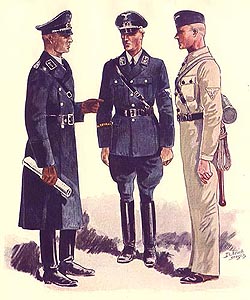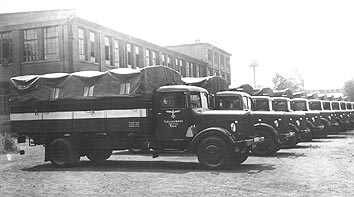The Technische Nothilfe in the "Third Reich"

TN-Emblem, 1935
After the National Socialists had took over in the Reich on January 30, 1933, the top leadership of the Technischen Nothilfe pursued a double strategy: On one side, a total adjustment was ordered for the organization to fit in with the new regime, with which the least conservative TN-members might not particularly be heavily pleased. On the other side, the new ruling powers had to be convinced of the indispensability of the Technische Nothilfe to the regime, because the example of other German national or conservative federations (e.g. the paramilitary federation Stahlhelm) had shown that just having the right conviction was not a guarantee, in order to escape a dissolution or an assimilation by NS federations.
Since strikes were in the meantime generally forbidden, the TN placed the technical disaster relief and above all the air protection service perfectly into the foreground of its work. It used its chance, before the NS organizations and stressed itself as an anticommunist technical organization in form. At the same time the TN practiced in public solidarity with the SA and SS. Thus it came to a form of "Live and Let Live": With marching-up, demonstrations and torch activities of the NSDAP, TN personnel were represented ever more frequent in closed groups, congratulated Hitler to his birthday or chanted slogans against the "shameful peace of Versailles".

TN service uniforms, 1936
On the other hand, the Technische Nothilfe instructed SS men in emergency bridge construction. SA troops imposed themselves upon the Technischen Nothilfe in order to be allowed to participate as auxiliary police during air raid protection exercises of fire brigades and the German Red Cross. This political relationship of the TN-guidance with the NSDAP paid off rapidly: New guidelines were issued on October 19, 1933, and Hitler personally expressed acknowledgment to the 15th anniversary of the founding of the TN on September 30, 1934. Both were equal to a guarantee of continuance as an independent organization. Nevertheless, the founder and executive leader of many years of the TN, Otto Lummitzsch, was replaced in 1934 by SA Gruppenführer (= Lieutenant General) Hans Weinreich.
In 1937, the 1st implementation regulation to the Luftschutzgesetz (Air Raid Protection Act) assigned the TN with the "special task of the repair service branch within the air raid protection service". At the same time Himmler risked everything in order to convert the TN gradually from a registered association into a technical auxiliary police force. This development found its conclusion with the entry into force of the Gesetz über die Technische Nothilfe (Technische Nothilfe Act) of March 25, 1939. At this time, co-operation with the SA was something of the past. Now the TN wooed the fire brigades, with which, it would form in the coming war "shoulder at shoulder and with same rights and obligations [...] the technical backbone of the air raid protection service". Intensive contact came also with the armed forces, into which TN mobile units had already stepped into action during the occupation of the Sudetenland.
In the local groups the normal service enterprise continued to a large extent its usual course, and with the time, when the existence of the TN seemed no longer endangered, also the co-operation was led back toward political demonstrations, a still tolerated lower measure allowed by the ruling powers. The Hilfspionierdienst (Auxiliary Pioneer Service = technical disaster relief) practiced the building of auxiliary foot bridges, the rescue of people from destroyed houses, and the digging of covering trenches. For these purposes the concept of the Motorisierter Bereitschaftszug (mot. BZ, Motorized Readiness Platoon) was developed between 1937-1939.

Line-up of Motorized Readiness Platoon vehicles on the
Metz factory site at Karlsruhe, 1939 (Picture: Metz)
Signal echelons tested the use of the still very simple, often optical transmission procedures. The TN had been directly trained by the urban supply organizations in enterprise and repair of their appliance and networks. The Gas- und Luftschutzdienst (Gas and Air Protection Service) rehearsed emergency missions under air war conditions in cooperation with fire brigades and the German Red Cross. This branch also took part in the self-protection training of the population. The main goal was to professionalize the help assistance according to the model of fire brigades.
With start of the war the Technische Nothilfe was divided to a certain extent into two halves: The younger people liable for military service as emergency helper aides were called up for the 1939 Polish campaign and again 1940 in France. In the occupied areas, the TN was responsible for the repair and the emergency operation of conquered vital enterprises. Older TN members and those not field service-capable remained at their homeland locations, in order to form the core of the repair service within the air raid protection service. In 1941 all persons liable for military service were transferred to the armed forces, thus the role of the TN members shank and as there were no more available for the civil air raid protection.
Due to the departure of the younger members, the local TN groups had become mostly much too small in order to be able to fill up the air raid protection units exclusive with their own personnel. Therefore, physically and technically suitable individuals would additionally be emergency service-obligated. In addition, skilled workers, masters and engineers were in other places very much in demand, often in pretty indispensability positions by armament enterprises or required as specialists by the armed forces. Other air raid protection branches - in particular the fire and gas protection service - had also constant need for personnel. So the units of the repair service were usually understaffed and consisted of hopelessly overaged and badly qualified or equipped personnel. A stopgap solution like the HJ-Feuerwehr (Hitler Youth Fire Brigades), in which young people between 15 and 18 years old strengthened the regular depleted crews, did not exist for the TN and the repair service. In May 1945 the TN organization - or what had remained of it - was dissolved of the Allied forces.